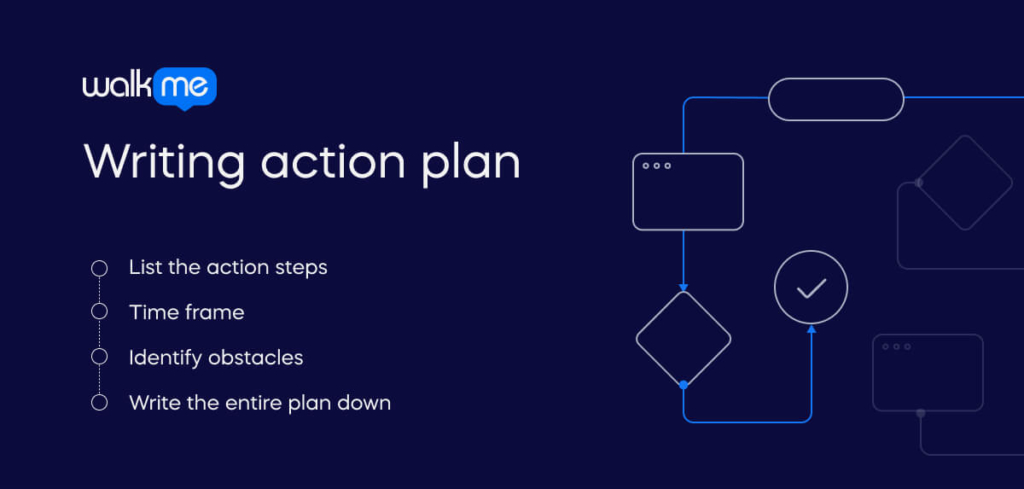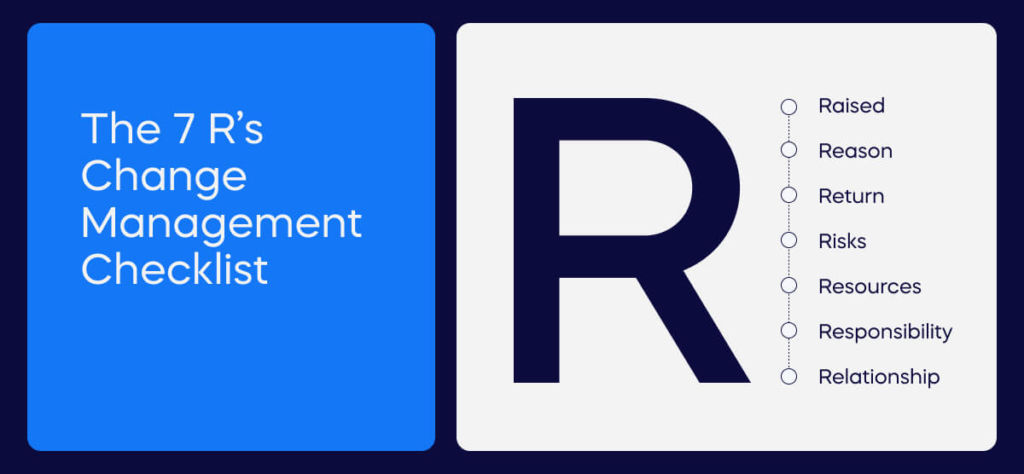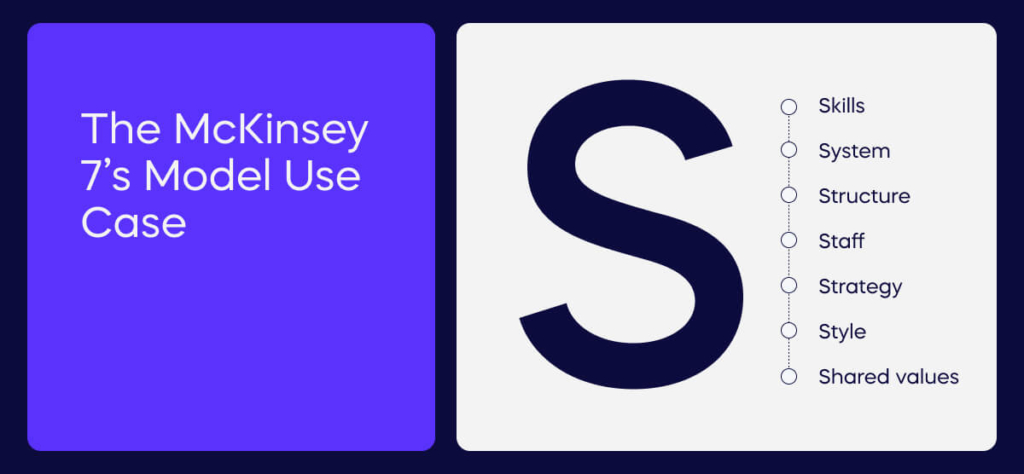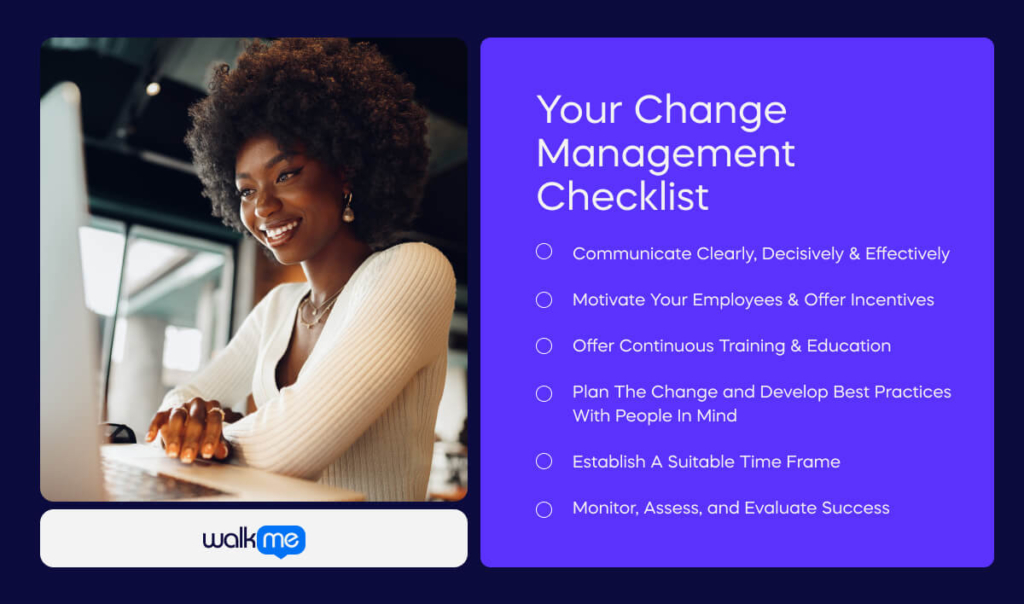Change is necessary for any individual or organization, helping us grow, develop, achieve digital resilience, and stay competitive.
Those who stay at the same place completing the same routine tasks find their work or lives monotonous and thus see no fulfillment in whatever they do, leading to employee performance metrics data.
But although change is good and essential, not many people desire or appreciate it, especially in a job setting. That is why managers must develop an action plan that leads to a smooth transition from one environment to another.
The managers should design a change management action plan that helps the employees trust and love the new system or way of doing things, clearly showing them what should change, why it needs to happen, and how it will take place smoothly.
The Groundwork
Begin with the groundwork to create a strong base for your change management plans.
What needs to change?
First and foremost, there is a need to identify the problem before making a change request. You can’t give a solution to a problem you have not determined yet, so first, you need to see what is currently wrong and what works.
If something is not working, find out why by engaging the people responsible or the clients. If it’s terrible communication, a technological problem, or a lack of direction and leadership, identify the cause.
Factors that signal a need for change:
- Unsatisfactory performance in a department or overall organization
- Lacking alignment between the business and the market.
- Competitors outperform your organization.
- A new opportunity.
Brainstorming Session
After pinpointing the problems and their causes, you need to seek solutions. Most leaders strain to come up with solutions to all problems alone, but this may not be the best way.
Reasonable solutions lie with those who consistently interact with the systems: the clients, staff, and leaders. It is suitable for managers to hear other people’s answers.
It is also necessary to research and see what others did when they had the same problem, discovering what works and what doesn’t.
You might like McKinsey’s seven steps to brainstorming:

- Start by understanding your organization’s decision-making criteria.
- Use the right questions to guide and generate ideas.
- Pick only the people who can answer your questions to brainstorm.
- Brainstorm in highly focused sub-groups instead of one long discussion. Each group discusses one question.
- Before starting the discussions, orient all the members about your expectations on what they should accomplish.
- After the meeting, each group narrows down the top ideas on their list.
- Follow up on the decisions on the ideas quickly – which ideas did the execs pick?
The Solution
The board or managers then need to sit and discuss all the proposed solutions and narrow them down until they come up with just one or two. While others give their input, it is the responsibility of the managers to decide what change will happen.
After determining the changes the organization is willing to take, create your change management plan.
Writing the Action Plan

1. List the action steps
Decide how the organization will achieve the needed change, then set measurable goals for every department. You can leave the specifics and logistics to the respective departments.
This step is the first of your change management project plan. The next step is to create a list of all the steps/tasks your teams will need to perform to implement the change, the deliverables, the people responsible for the functions, and their timelines.
While assigning tasks, involve the employees in building loyalty and empathy.
Ensure that you identify the skill sets and resources needed, even from consultants and other outside players. Project managers typically work with change managers to align the change initiatives with the project management plan.
For the change team, you need a change manager to oversee the initiative, a change process owner to define change processes, and a change control board to review change requests.
The budget should also be very realistic to avoid financial setbacks.
2. Time frame
The change management team has to set a suitable pace for the firm. If it is too fast and abrupt, it might confuse the employees. If it is too slow, they could lose interest and momentum. Gauge your firm’s ability, the client’s requirements, and the need for this change. Then, determine the start date and duration of the project to create your change management roadmap.
Typically, change management efforts begin way before the changes go live. Three months could help employees understand the reasons for the change and what management expects from them.
3. Identify obstacles
A smooth change does not come because there are no obstacles; it comes because the managers identify them and plan how to circumvent them. The change management plan has to consider the barriers. List those you feel might arise. The process is part of a change readiness assessment.
A change readiness assessment evaluates the organization’s capacity for change. The goal is to identify resistance areas, risks, and cultural barriers to the change. The assessment’s results will inform the resistance and overall project management plans.
Below’s the process for conducting a readiness assessment:
- Start by describing the change fully.
- Choose your assessment tools, e.g., questionnaires, benchmarking tools, etc.
- Gather initial feedback about individuals’ awareness of the change, willingness to adopt it, and their view on the organization’s capacity to implement it.
- Interview key individuals (those with influence) – managers, senior leads, etc.
- Summarize and analyze your findings.
4. Write the entire plan down
You can write down a detailed and less detailed organizational change management plan for managers and junior employees.
Show the problem, list the advantages of the change, and demonstrate the stages involved. Include the people in charge of every step after identifying their strengths.
Do not forget the budget and change management resources needed.
Also, take a look at a change management template. Change management templates can help guide your plan quickly, forming a basis for later decisions from the change request stage to review.
The Seven Rs Change Management Checklist

The seven Rs are seven questions that organizations use to assess the effectiveness of their change management process in IT environments. Answering these questions also helps organizations set metrics for measuring change risk and pinpoint gaps in the change process.
Raised – Who raised the change?
A record of authorized changes is beneficial when auditing the change management plan. So, organizations develop a system for authorizing and recording changes at a central point. Answering this question keeps track of the many sources of change and siloed changes.
Reason – What’s the reason for the change?
Answering this question helps manage change risks because only changes with business benefits will go through.
Organizations create a process for validating the reasons for changes, and every significant change goes through an assessment to prioritize changes and expose potential misalignments that would waste resources.
Return – What return do we require from the change?
Answering this question determines the financial impact of a change. Hence, it helps to prioritize changes.
Risks – What are the risks involved in the change?
Determining the risks of implementing and failing to implement a change helps determine whether to mitigate or accept risk. Since all changes involve risks, change leaders assess severity.
Resources – What resources do we require to deliver the change?
Answering this question determines the skills needed to implement a change and their availability. It also determines the infrastructure assets required to execute the change. And the change’s impact on other project resources (people, assets, time, and money).
Responsibility – Who will build, test, and implement the change?
Managers assign the people to handle the three functions (build, test, and implement change). However, the entire change management team should be able to trace and enforce these responsibilities.
Relationship – What’s the relationship between the suggested change and other changes?
Determining the change relationships from within and across functional boundaries helps complete the project within the allocated timeline because there are always many concurrent changes in the IT environment.
Change impact analysis and shared scheduling of planned changes help determine these relationships.
How Change Management Models Evoke Sustained Action
Change management models are methodologies and theories for approaching organizational change based on what other successful organizations have done.
Like maps, they provide direction for planning and implementing change. They show change practitioners what to expect and how to prepare.
For example, McKinsey’s 7-S model identifies seven critical components of change that leaders should focus on during a transformation. Some of the components may not come to a leader naturally.
Other change models include the ADKAR model, Kotter’s 8-Step model, Lewin’s 3-Stage model, and the Satir change models.
Change models provide a structure that makes change manageable. They help to forecast change processes so that people can prepare.
They also provide a baseline for measuring change efforts (adoption rate, professional efficiency, time, and budget). And they ensure accountability by clarifying roles and responsibilities.
A change management model also helps identify areas that are resistant to change and create strategies to prevent opposition, including a communication strategy.
Organizations can achieve the desired outcomes from a transformation when following a structured approach.
The McKinsey 7 s Model Use Case

Former McKinsey consultants developed the 7-S framework in the late 70s to diagnose how existing organizations operated and create tools to help them address seven particular elements in change that aren’t natural to leaders.
It’s a cluster of six circles surrounding a central process, each representing a factor beginning with S influencing an organization’s ability to change.
The 7 S’s are:
- Skills – Institutional and individual skills.
- System – Processes and systems.
- Structure – Who’s in charge (authority relationships)
- Staff – The people, and you grow and develop them.
- Strategy – What’s the organization’s approach to gaining a competitive advantage?
- Style (or culture) – The way the people do things.
- Shared values– What’s the organization trying to achieve?
Organizations use the framework to coordinate these interrelated factors that influence an organization’s ability to change. The lack of hierarchy in the framework suggests that they all work together – significant progress in one aspect will be difficult without the others.
Companies can also use the framework to examine the effects of changes or align processes during mergers.
Here’s how to use the 7-s model:
Start with the organization’s shared values as part of an effective change management plan. Ensure all values are consistent with the strategy, structure, and systems. Then, assess how well the design, layout, and systems support each other.
If not, determine what needs to change. Then, consider how well the other four elements (skills, style, staff, and shared values) support each other and how they support the strategy, structure, and systems. The process is often iterative.
Your Change Management Checklist

Successful organizational change needs a change management communication plan, training plan, and reinforcement plan (e.g., using incentives). You also need to measure and analyze the change process.
Communicate Clearly, Decisively & Effectively
McKinsey’s research identified that fostering understanding and conviction in employees is necessary for successful organizational changes.
Besides getting the employees to participate in the change, clear communication helps employees understand the differences, why they’re required, and how they’ll impact their lives.
But on the ground, organizations merely announce the changes and hand off a list of tasks to middle managers.
Clear, decisive, and effective communication in organizational changes involves these appproaches:
- Leaders show vital stakeholders and employees what the change is about, what it involves, and its full extent. Why change now? What will be the outcome of the change? And how will we measure progress? And significantly, how does this change link to other strategies?
- Leaders live the change. It means scheduling time to discuss progress with middle managers and creating time to discuss issues as they arise. It could also mean putting the difference at the top of every senior meeting agenda.
- Leaders resource the change and measure progress. Allocate finances and the right people to implement the change. And start measuring the right metrics early on to craft the right organizational structure.
Motivate Your Employees & Offer Incentives

A survey found 87% of employees feel included when a company has a strong recognition culture. Incentives are one way to recognize your team’s efforts and motivate them.
“When employees were seeing their friends get bonuses, you won’t believe the number of people who swung by my office and asked me how they could roll up their sleeves and play a role in the transformation,” one chief transformation officer told McKinsey’s researchers.
However, the key is to reward the employees after they deliver the value of the change. And the incentives should not be financial only. We need to complement financial incentives with nonfinancial ones like recognition. It’s about making the transformation meaningful to employees.
McKinsey identified the five sources of meaning in work as society, company, customers, team, and personal success. So, nonfinancial incentives should appeal to either of the sources of meaning.
A primary way to motivate employees is by celebrating small wins. Since most transformations take months, it’s easy for employees to lose morale when they don’t see progress.
Record progress by having micro milestones for the change project and celebrating every small win (including communicating the victory throughout the organization).
Supporting employees in their work also motivates them. So leaders must set clear goals, allow autonomy, provide the necessary resources and time, openly learn from problems and successes, and allow employees to exchange ideas freely.
Offer Continuous Training & Education
Developing talent and skills is another building block when managing change. And 69% of the most effective change management programs offer training before and after the difference goes live.
That demands different types of training content – videos, webinars, live sessions, and knowledge bases. But instead of relying only on such training sessions, organizations use digital adoption solutions to offer continuous self-service training and education.
For example, when LinkedIn rolled out its HCM software, it integrated the WalkMe digital adoption platform (DAP) into the software, which reduced its live training sessions by 48%. Employees could access in-app on-screen guidance just when they needed it using WalkMe’s Walk-Thrus and SmartTips.
The HRIT team identified the top 36 transactions on the HCM and designed Walk-Thrus to guide users through each in real time. The SmartTips provided contextual guidance – answering simple questions without leaving the application.
Beyond employee training, organizations must also develop leaders’ skills to facilitate change.
Plan The Change and Develop Best Practices With People In Mind
Organizations where a central change team plans the change but fails to consider the employees who will implement change end up with overstrained employees who can’t adapt. And since many change initiatives fail due to employee resistance and lack of support from management, a successful change management plan must prioritize the people.
Here’s how to have an employee-centric change management strategy.
Change leaders should first understand the workplace ecosystem to remove obstacles, mitigate risks, and support employees in navigating the changes.
Second, management should be transparent about the usual business processes and the impact of the change on the employees.
Third, change leaders should have the willingness, skills, and knowledge to guide employees through the transition.
Establish A Suitable Time Frame
Time management in change management involves giving enough time for research and planning, giving employees enough time to understand and adjust to the changes, and allowing ample time for training.
Organizations should give employees adequate time to process the changes before implementation begins. For example, start communicating with employees way before selecting an ERP system.
That way, you’ll have enough time to integrate change management into the project plan. The project team members will know the essential people-focused activities and how to support them.
So, when creating a change management plan, make a reasonable timeline for the change management activities. Naturally, the change management timeline should align with the overall project timeline. Assign due dates for each task and prioritize accordingly.
The change management plan examples on this site have sample timelines for inspiration.
Monitor, Assess, and Evaluate Success
Change teams must have a system for analyzing the effectiveness of the change management process and adjusting as needed. That means having metrics to determine the outcomes of the change and performance at the individual and organizational levels.
We’ll divide these metrics into organizational performance, individual performance, and change management performance.
Organizational performance metrics:
- Adherence to the project plan using the best project management software.
- Project KPIs.
- Benefits realization and ROI.
- Execution speed.
- Adherence to the timeframe.
- Project management tool metrics features.
Individual performance metrics:
- Employee satisfaction survey results.
- Awareness and understanding of the change.
- Employee feedback.
- Stakeholder buy-in.
- Employee engagement.
- Number of support requests.
- System usage reports.
- Error logs
- ADKAR model surveys
Change management performance metrics:
- Adherence to the timeline
- Project KPIs
- Execution speed
- Performance improvements
- Commitment to the project plan
- Communication effectiveness
- Training tests results
- Training participation
Change Management Made Easy
Using the change management plan example and checklist above, creating a change management plan is easy.
The essential elements for managing change are clear communication, ongoing support and training, a motivation plan, and change effectiveness metrics.
Clear communication helps everyone understand the need for the change and what the change involves. The leaders also need to embody the change in their daily actions.
That means scheduling time to discuss the change processes with managers and being available to discuss issues that may arise.
Organizations can provide ongoing support with a digital adoption tool and motivate employees with bonuses and recognition. Finally, have metrics to analyze the change management plan and the overall project.
Change management models like McKinsey’s 7-S and ADKAR model provide a structured approach to change. They provide direction and forecast on what to expect and how to prepare for different issues during organizational changes using the best change management processes.

